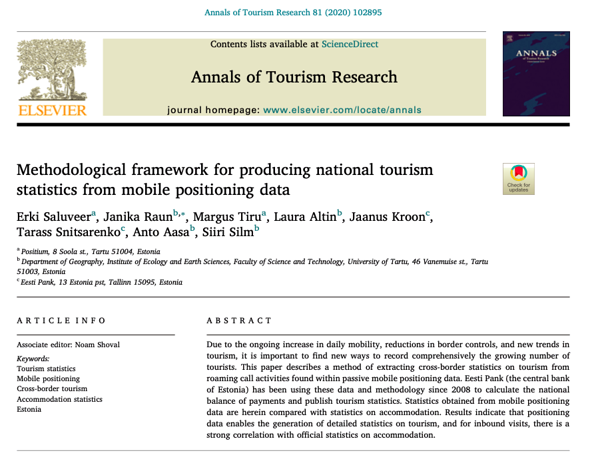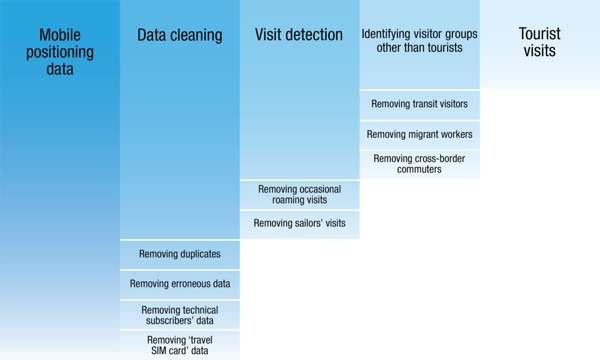The article is a great feat of industry-academia-government collaboration that has lasted over a decade. The aim of this paper is twofold:
- to describe a method for extracting cross-border tourism statistics from roaming data for an entire country, Estonia, and
- to evaluate the representativeness of the results derived from mobile data compared with accommodation statistics.
In the chapters concerning the methodology employed, it is explained how the data is collected and cleaned, and how visits are detected and classified based on their duration and aim. Based on duration, same-day and multi-day visits are identified. Based on function, transit visitors, migrant workers, cross-border commuters, and tourists are distinguished. Thereafter, monthly and yearly numbers of tourist visits and visitors, and the number of nights and days spent by country of origin are calculated. In the results section, the representativeness of mobile positioning-based statistics is assessed by comparing them to the monthly number of nights spent at accommodation establishments by country of residence.
“Getting from a source of big data to official statistics is a long chain of processes that have to be designed and executed with high precision. This paper introduces the methodology of how Estonia set up the world’s first big data project for producing official tourism statistics using mobile positioning data,” says Erki Saluveer, CEO of Positium, on the importance of publishing a methodology article. “The producers of official statistics are under pressure to provide faster and more detailed data for governmental institutions as well as for the public. The only solution to this would be to start using big data sources, but these come with their own problems,” he stated. However, Saluveer remains hopeful for the future of statistics: “Opening an academic discussion on this matter will hopefully lead to wider use of big data for official statistics.”
We also spoke with our partners at Eesti Pank and the University of Tartu about the significance of this article. Jaanus Kroon, the Head of the Statistics Department at Eesti Pank, looked back at how the collaboration between the parties involved began: “After the last financial crisis, Eesti Pank was looking for novel methods for statistics production as many of our important sources of time-series data were cut. The same happened with cross-border statistics, which was influenced by Estonia becoming a part of the Schengen area. We had to find innovative solutions and the best option for data input seemed to be mobile positioning data from log data. At the time, we proposed this idea to the human geographers at the University of Tartu who already had some experience in using such data. It was the start of a partnership that’s lasted for more than 10 years and is still going strong today. The article gathers the knowledge gained from our partnership over the past decade. Ten years ago people mostly shrugged at our presentations on mobile positioning. Today, however, big data is a prospect and challenge for nearly all statistical organisations. And we have the honour of being one of the first ones in this field.”
At the Mobility Lab of the University of Tartu, mobile positioning data has been used for over 15 years. Janika Raun, a Junior Researcher at the University of Tartu, told us a bit about how the methodological developments were summarised in an article. “Developing and improving methodologies for using the data in various scientific fields has been an integral part of our everyday work and of utmost importance for scientific advancements. However, finalising these developments in the form of a scientific article is a difficult and long process. Thus, we can say that the paper on the methodology of tourism statistics is only the second significant methodological article published since the anchor point model paper (Ahas et al*) in 2010. Therefore, we are especially proud of it, as the published methodology backs many other empirical research articles. The scientific value of the methodology lies in the possibility of detecting and distinguishing different mobility types (e.g. transit visitors, migrant workers, cross-border workers) that are impossible to capture using only traditional datasets.”
Read the full open article here:
https://www.sciencedirect.com/science/article/pii/S0160738320300396
Saluveer, E., Raun, J., Tiru, M., Altin, L., Kroon, J., Snitsarenko, T., Aasa, A., & Silm, S. (2020). Methodological framework for producing national tourism statistics from mobile positioning data. Annals of Tourism Research, 81, 102895. https://doi.org/10.1016/j.annals.2020.102895
*Ahas, R., Silm, S., Järv, O., Saluveer, E., Tiru, M. (2010). Using Mobile Positioning Data to Model Locations Meaningful to Users of Mobile Phones. Journal of Urban Technology, 17(1), 3–27. https://doi.org/10.1080/10630731003597306
.png)

